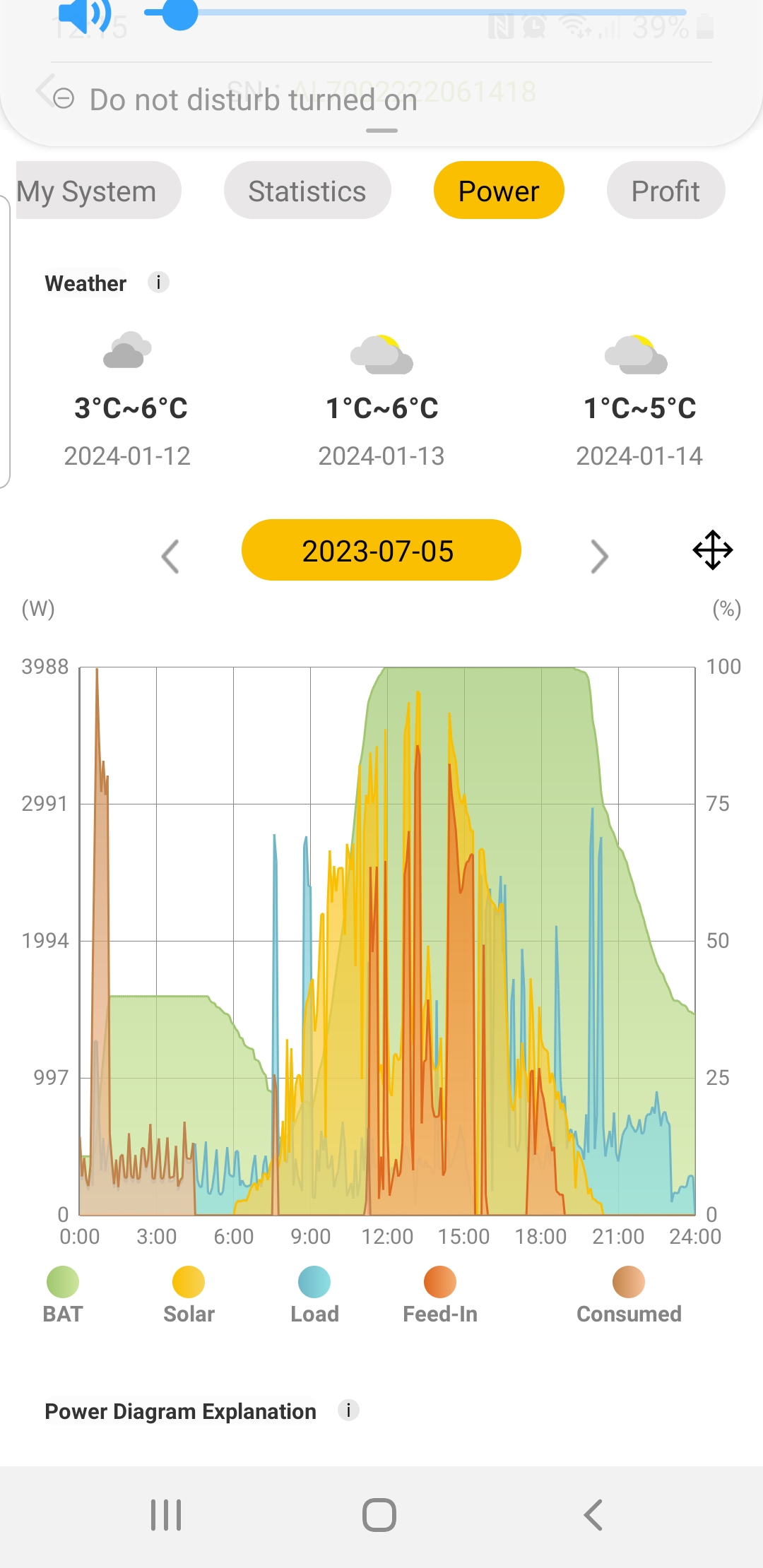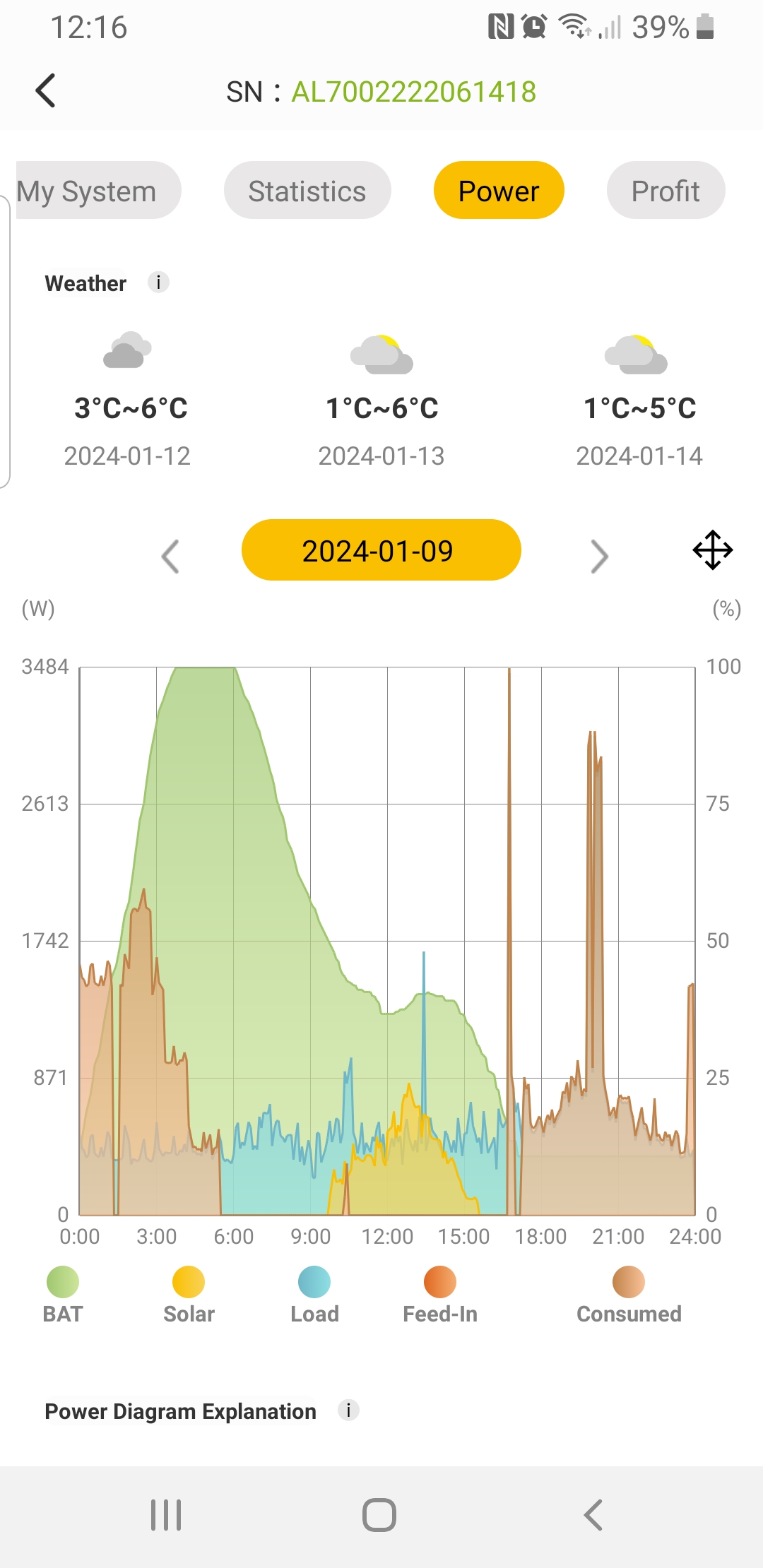With the government announcing that VAT will be zero rated from February on retrofitted household electrical battery storage solutions, it seems an appropriate time to write up my own experience of retrofitting and living with an AC battery in our 1930s Chippenham house.
Following an industry wide consultation in 2023 the UK government announced the following changes from February 2024…
The government recognises the integral role that electrical battery storage can play in reducing households’ reliance on the grid, both when retrofitted to a qualifying ESM and when used as a standalone technology connected to the grid.
This technology already qualifies for VAT relief when installed alongside a qualifying ESM, as it is ancillary to a zero-rated supply. The government agrees with respondents, though, that this technology meets all of the stated objectives for this VAT relief in its own right, and will therefore bring electrical battery storage within the scope of the relief. This means that the technology will now also qualify for VAT relief when either retrofitted to a qualifying ESM, or installed as a standalone technology connected to the grid.
Background
As an administrator for the Zero Chippenham Community Solar scheme i’ve been taking steps to retrofit our 1930’s semi detached house on Langley Road, Chippenham. I installed 4kW of Solar PV generation on our house during lockdown and absolutely love generating our own solar electricity. As I installed solar panels on a flat garden room roof, I took the slightly unusual approach of using micro inverters behind each panel rather than the more usual single electrical inverter. This helps with the shading of some panels that occurs with our garden trees, surrounding houses, and relatively low installation height.
It’s very satisfying generating your own renewable electricity, but you do need to be able to use it during the daytime hours of generation. For most people this doesn’t coincide with their daily life where most usage often occurs first thing in the morning or during the evening.
With modern appliances it can be possible to work around this, setting your washing machine on a timer to run at lunchtime when solar generation is high, for example. If you have an immersion heater water tank a popular solution is to use a device such as an Eddi or an iBoost. These devices divert excess solar to heat your domestic hot water. The other possibility is signing up to the Smart Export Guarantee and get paid for the excess solar you export.
However in the last few years battery technology has improved and reduced in price to the point that it is now a feasible alternative for storing excess solar electricity. This has also combined with the introduction of different smart tariffs making the possibility of installing a standalone battery without solar a realistic possibility in terms of payback time.
It’s worth taking a quick look at what an inverter is, for those that know please skip this part….
Hybrid Inverter
If you had solar panels fitted in the last two or three years you may have opted for a so called hybrid inverter. A hybrid inverter is effectively a ‘battery ready’ inverter capable of not only connecting to your solar panels and supplying your house, but also capable of charging a battery when excess solar is available, or when programmed to do so e.g. at night on a cheaper electricity tariff.
If you have a hybrid inverter then retrofitting battery storage should be an easy option as it won’t require a new inverter.
If you have an older solar installation or didn’t opt for a hybrid inverter then retrofitting is still possible. You could opt to change your inverter to a hybrid inverter and battery, or you could fit a so called ‘AC Battery’.
If your solar installation received the Feed In Tariff (FIT), then you may want to leave it alone and a standalone AC battery may be the best option. Similarly if you have an MCS certified installation and you can’t contact the original installer, you may be better off leaving it as is, and installing a standalone AC battery.
Choosing my AC battery
For our Zero Chippenham solar scheme we work closely with Beazer Electrical in Corsham. Most of our solar enquiries in the last 18 months have requested a battery installation and Beazer are able to accommodate this.
Hence Beazer were my first stop when enquiring about an AC battery. As I trained as an electrician and spent the early half of my career as an electrical, electronic, and software engineer; John from Beazer was happy to guide me and source the battery with an eventual sign off of the installation. This isn’t the usual path, but as we offer informal advice at Zero Chippenham, I do like to have ‘walked the walked’ in terms of the process so I can advise from experience.
The AC battery I chose was the Alpha Smile B3 plus 5kWh.
I chose this for three reasons…
- it could be installed outside and had a suitable IP rating
- it was Lithium Iron Phosphate chemistry which is more stable and contains no cobalt or nickel
- it was a relatively low price.
Budget was important for me, and though I would have liked a Tesla Powerwall, the truth is I couldn’t afford one at the time. The battery was also scalable allowing future expansion if needed.
There was also the matter of payback period. Whereas most solar installations have a life of 25 years, a battery guarantee is typically 10 years. Not that you would expect the battery to instantly fail, but it will degrade over time. So if I spend £3000 installing a 5kWh battery will it pay for itself?
Installing the AC Battery
The battery arrived at our house straight from the wholesaler on a pallet. The one thing about house batteries is they are really, really, heavy. In this case approx 60kg.
So whilst some people do mount them in a loft space, for us with our creaky 1930s beams I wouldn’t even consider this option. There is also the potential risk of fire. Whilst the Lithium iron Phosphate (LiFePO4) chemistry of the battery is known to be extremely thermally stable, I was much happier installing the battery away from our main house.
I decided to install it at the rear of garden room where it is shaded from sun and shielded somewhat from rain. Taking John’s advice I created a Unistrut floor mounted steel frame such that the battery weight was supported on the ground, and the fixings to the garden room weren’t weight bearing. I co-opted my son to help me lift the battery. It took us three attempts to get it hooked on to the mounting bracket.
The electrical installation side was really quite straightforward. The battery needed its own circuit connected into out garden room consumer unit with its own 40A RCBO circuit breaker. The size of the breaker is recommended by the manufacturer and I assume is so large to prevent nuisance tripping. This did however require a correspondingly large cable which was rather difficult to work with.
The battery also required the installation of a lockable rotary Isolator next to it for any electrical work, and safety stickers at our two consumer units to indicate a battery was in operation and should be isolated if electrical work were undertaken.
The Alpha also required the installation of two Current Transformers (CTs), one connected around our Solar AC supply live, and one connected around our incoming Grid supply live just after our electricity meter. Luckily I had previously had the foresight to run a multi twisted pair cable from our electricity supply cupboard to the garden room for our solar PV installation, and had a spare twisted pair available.
These two CTs allow the Alpha Battery to know when excess solar is being generated and charge the battery, or when more power is being used than solar is generating, so battery storage is then used to supply the house.
Commissioning the AC Battery
If you were going through the Zero Chippenham Solar scheme and requesting an AC battery, you wouldn’t need to worry about this next part, this is what the installer does for you. But I include it here as possible useful additional information.
When you install your own micro-generation on a domestic house, either solar, or battery storage, the electricity supplier needs to know. More accurately the Distribution Network Operator (DNO) needs to know, and for Chippenham this is Scottish and Southern Electricity. They need to know this so they can manage the grid, ensure that the supply to your neighbours houses stays within defined limits, and for safety reasons when network maintenance is required.
If the installed micro-generation is 3.68kW or lower, then a post notification is required using a G98 form. This is done by your installer. Note the 3.68kW is defined by the inverter capacity, in the case of solar you might have greater capacity panels than this, particularly if your house is East West facing.
So, if you already have a solar installation with a hybrid inverter adding battery capacity isn’t a major challenge as your inverter size won’t change.
However, if you’re adding an AC battery to your solar installation things are a little more complicated. The DNO sees this as potentially two generators (as you have two independent inverters), and in the worse case scenario with a potential export total to the grid of 7.36kW. So even though that’s not how you’re likely to use the installation as you’ll most likely be storing the solar in your battery to supply your house in the evening, the DNO will require your installer to submit a prior notification form G99 before work commences.
The DNO may then require that your household export generation will be limited to 3.68kW using a G100 form. Still with me?
So, I achieved this using a grid profile on my solar setup that limited export to 3.6 kW and managed to achieve prior approval. It did require a bit of a discussion with John at Beazer to cross check my reasoning, and Scottish and Southern signed it off.
You shouldn’t need to worry about this as your installer will do this for you, but it can cause a delay to the installation, and it may mean the installer needs to add additional components or have a preferred method to achieve this. The DNO forms aren’t particularly user friendly!
I also had to carry out commissioning tests and send to the DNO to prove that the export limit worked. Again this is something your installer will do.

Day to Day usage
I’ve been really pleased with how the battery operates in the day to day. We are a reasonably high electricity usage household of four people. Though the main house is still heated by a combi boiler, we have electric heating in our own home office, and a small electric underfloor pad in our bathroom. We have a dishwasher, a washing machine, and the usual teenage household accessories; we also bake a lot making bread daily. I was very impressed with the speed at which the battery detected changes in load and seamlessly switched operation. Switch a kettle on or a toaster and it reacts straight away.
One advantage of an AC battery that I hadn’t considered until using it, was the slightly advantage of having two inverters, ie a solar inverter and a battery inverter. If solar production is good, and our oven is on, and I switch the kettle on, because our combined solar and AC battery inverter capacity is 7kW, we don’t draw from the grid. With a hybrid inverter and battery the total combined solar/battery ability to respond to loads would be limited by the size of the single hybrid inverter typically 3.68kW. So switching on the kettle with the oven running would cause the additional electricity to be supplied by the grid even if your battery is charged and the sun is shining.
The Alpha Ess App was easy to use, the battery connects to our home wifi via a dongle on top of the battery, and I find that I tended to use the low night time electricity rate to top up the battery to around 25% in the summer, rising to 100% in the winter.
In the summer I found the night time small top up was enough to supply the breakfast period, before solar kicked in and started to charge the battery again. In summer I was able to run on solar and battery alone until midnight and annoyingly still ended up exporting excess solar to the grid.
In the winter I charge to 100% at night, and if i’m lucky make it to around 6pm in the evening before importing from the grid. I had seen some concerns on forums about charging the battery at low temperatures. I noticed it failed to charge to 100% on a night when temperatures were near freezing. As Intelligent Octopus gives a potential 6 hour charging window I widened the charge window and this seemed to work, allowing the battery to charge at a slower rate over a longer period.
The only thing I might try and add in is a form of weather prediction. Knowing whether the next day will be cloudy or sunny makes a real difference to how much you need to charge the battery at night. I know some people have automated this via Home Assistant, so it’s on my list.
I’m glad I fitted the battery in a relatively sheltered position, as though it’s rated for outdoor installation, i’m not sure the covers would keep out heavy rain ingress.
It’s perfectly quiet in operation.

Summer Usage
Battery and solar can supply the house until midnight with some export. I still had some night charge set here. Trying to guess the next day’s cloud coverage.

Winter Usage
The battery is charged to 100% overnight. It lasts until almost 6pm
What about Carbon Savings and Ethics?
Whilst battery technology is undoubtedly now part of the path to net Zero worldwide, there are understandably questions about the ethics of their production and how much carbon they save. Whilst much of this accusation has come from the fossil fuel lobby and incumbent industries, there are some Zero Chippenham members who are concerned about the environmental impact of battery production.
So we should look in detail at the ethics of battery production and how much carbon is saved.
Are batteries compatible with net zero?
What about slave labour and mining?
Whenever batteries are discussed a frequently mentioned point is the horrors of forced and child labour in mining. How accurate is this information?
As someone that set up and ran a chocolate business for many years, I know more than most about the horrors of child and forced labour in supply chains. The latest estimate by the US government is that 1.56 million children are in child labour in the cocoa supply chain in West Africa. This cocoa is used by all the major chocolate brands including a well known entrant whose unique selling point is they are slave free!
The truth is many of our day to day chocolate products, clothing, and anything with a long supply chain, is likely to contain some form of labour practice that fails to meet ethical standards. That’s not to condone it, it’s awful. But we should perhaps ask why these stories are consistently focussed on batteries?
One of the main elements of concern is Cobalt. This has been a key element in the cathodes of Lithium ion batteries and is associated with some terrible labour practices in the Democratic Republic of Congo (DRG) (75% of the world’s cobalt mining) including child labour. Around 5 – 10% of the DRC cobalt supply is of concern.
It should be noted that Cobalt is extensively used as a catalyst by the Petro chemical industry, though this is less widely publicised.
The Lithium Iron Phosphate battery chemistry used in my house install is Cobalt and nickel free as are all LFP batteries.
There is also of the course the widely publicised use of forced labour in some manufacturing in China. I have to admit I don’t know if that could be the case for our battery, I just don’t have the detail, though they have recently set up a manufacturing site in Australia and are transparent on their Environmental and Social Governance report.
Personally I welcome these investigations as it will force companies to improve supply chain sourcing and practices. But we should look at all supply chains and products and also question why some of these stories continually appear in the press. It is an uncomfortable issue and something we should all consider in our purchasing.
Nonetheless I believe batteries are here to stay and their manufacture will continue to improve. The new Sodium ion chemistries are particularly exciting I think.
The real truth is the best carbon, environmental, and financial saving we can make, is through the energy we don’t use.
Conclusions
Would I recommend installing an AC battery?
Yes I would if you have a solar installation already without storage, but you will need to calculate your financial payback as a cross check.
As with all energy efficiency measures a fabric first approach is the one to take as the best savings you can make are through the energy you avoid using.
I would also consider the feasibility of a solar hot water diverter which is lower cost and lower embodied carbon. With the current drive for heat pumps and grants for those, using solar to power your heat pump in the summer and hot water might be a better alternative.
Matthew Short – Zero Chippenham member
If you are interested in exploring a solar or battery installation through Zero Chippenham please fill out the form on our Zero Chippenham Community Solar scheme page


